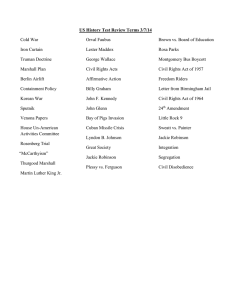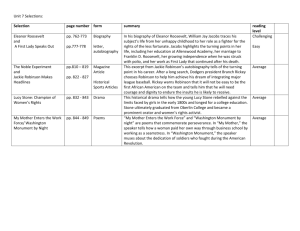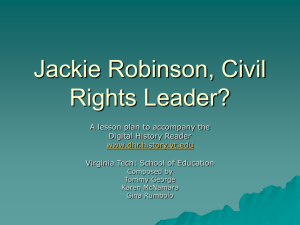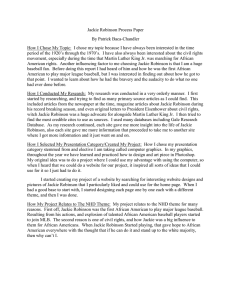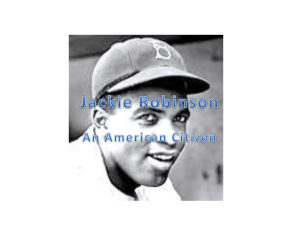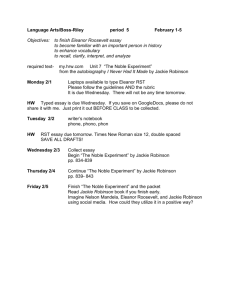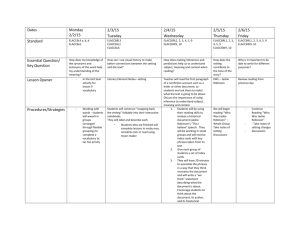Lesson Plans: 04 SS LPQ4 099 Jackie Robinson and the...
advertisement
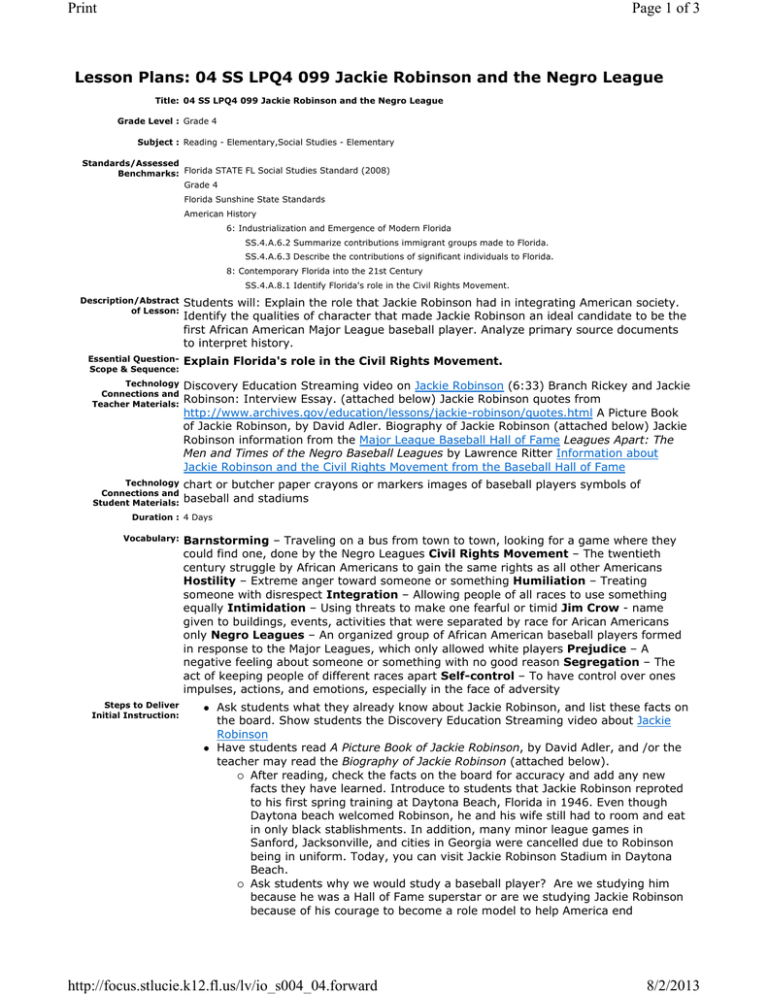
Print
Page 1 of 3
Lesson Plans: 04 SS LPQ4 099 Jackie Robinson and the Negro League
Title: 04 SS LPQ4 099 Jackie Robinson and the Negro League
Grade Level : Grade 4
Subject : Reading - Elementary,Social Studies - Elementary
Standards/Assessed
Benchmarks: Florida STATE FL Social Studies Standard (2008)
Grade 4
Florida Sunshine State Standards
American History
6: Industrialization and Emergence of Modern Florida
SS.4.A.6.2 Summarize contributions immigrant groups made to Florida.
SS.4.A.6.3 Describe the contributions of significant individuals to Florida.
8: Contemporary Florida into the 21st Century
SS.4.A.8.1 Identify Florida's role in the Civil Rights Movement.
Description/Abstract
of Lesson:
Essential QuestionScope & Sequence:
Students will: Explain the role that Jackie Robinson had in integrating American society.
Identify the qualities of character that made Jackie Robinson an ideal candidate to be the
first African American Major League baseball player. Analyze primary source documents
to interpret history.
Explain Florida's role in the Civil Rights Movement.
Technology
Connections and
Teacher Materials:
Discovery Education Streaming video on Jackie Robinson (6:33) Branch Rickey and Jackie
Robinson: Interview Essay. (attached below) Jackie Robinson quotes from
http://www.archives.gov/education/lessons/jackie-robinson/quotes.html A Picture Book
of Jackie Robinson, by David Adler. Biography of Jackie Robinson (attached below) Jackie
Robinson information from the Major League Baseball Hall of Fame Leagues Apart: The
Men and Times of the Negro Baseball Leagues by Lawrence Ritter Information about
Jackie Robinson and the Civil Rights Movement from the Baseball Hall of Fame
Technology
Connections and
Student Materials:
chart or butcher paper crayons or markers images of baseball players symbols of
baseball and stadiums
Duration : 4 Days
Vocabulary:
Steps to Deliver
Initial Instruction:
Barnstorming – Traveling on a bus from town to town, looking for a game where they
could find one, done by the Negro Leagues Civil Rights Movement – The twentieth
century struggle by African Americans to gain the same rights as all other Americans
Hostility – Extreme anger toward someone or something Humiliation – Treating
someone with disrespect Integration – Allowing people of all races to use something
equally Intimidation – Using threats to make one fearful or timid Jim Crow - name
given to buildings, events, activities that were separated by race for Arican Americans
only Negro Leagues – An organized group of African American baseball players formed
in response to the Major Leagues, which only allowed white players Prejudice – A
negative feeling about someone or something with no good reason Segregation – The
act of keeping people of different races apart Self-control – To have control over ones
impulses, actions, and emotions, especially in the face of adversity
z
z
Ask students what they already know about Jackie Robinson, and list these facts on
the board. Show students the Discovery Education Streaming video about Jackie
Robinson
Have students read A Picture Book of Jackie Robinson, by David Adler, and /or the
teacher may read the Biography of Jackie Robinson (attached below).
{ After reading, check the facts on the board for accuracy and add any new
facts they have learned. Introduce to students that Jackie Robinson reproted
to his first spring training at Daytona Beach, Florida in 1946. Even though
Daytona beach welcomed Robinson, he and his wife still had to room and eat
in only black stablishments. In addition, many minor league games in
Sanford, Jacksonville, and cities in Georgia were cancelled due to Robinson
being in uniform. Today, you can visit Jackie Robinson Stadium in Daytona
Beach.
{ Ask students why we would study a baseball player? Are we studying him
because he was a Hall of Fame superstar or are we studying Jackie Robinson
because of his courage to become a role model to help America end
http://focus.stlucie.k12.fl.us/lv/io_s004_04.forward
8/2/2013
Print
Page 2 of 3
segregation.
Guided Practice with
Feedback:
z
Independent
Practice:
z
z
z
Pass out the Branch Rickey and Jackie Robinson: Interview Essay. Have students
read the essay individually
{ Discuss Jackie Robinson’s interview with Branch Rickey. Ask students why
they think he chose Jackie Robinson to be the first African American major
leaguer.
{ Brainstorm a list of qualities Branch Rickey was looking for. Next to each
quality, identify prior events in Jackie Robinson’s life that exhibit these
qualities.
{ Divide students into pairs and have them answer the following questions:
Why does Branch Rickey think Jackie Robinson needs a girl? Do you
agree or disagree?
Why do you think Abraham Lincoln’s portrait hung in Branch Rickey’s
office? What does it represent?
What does “noble experiment” mean?
Why do you think Branch Rickey asks Jackie Robinson not to fight back
for three years?
What does Jackie Robinson mean when he says, “I’ve got two cheeks?”
Describe the courage it took for both Jackie Robinson and Branch
Rickey. Would you have had that courage?
{ Share students’ answers with the whole class. Revisit the list of qualities and
add to it as needed.
{ Have each pair of students write a script for Branch Rickey’s interview of
Jackie Robinson. Although the essay provides some of the words they used,
the students will have to make up most of the dialogue themselves. Remind
them that, although Branch Rickey may have used some foul language, they
must keep it clean for the classroom. After the dialogue is written, have each
pair practice and perform it for the class.
Review what the students learned yesterday about Jackie Robinson. Review the
chart of Jackie Robinson’s qualities. Tell students today they are going look at some
letters, telegrams, and quotes from Jackie Robinson. These are located at the
National Archives. Quickly discuss the National Archives and their purpose.
Prior to the lesson, copy each of Jackie Robinson's quotes onto a separate large
sheet of paper.
{ Randomly distribute the quotes, then have one student at a time come to the
front of the class and read the quote.
{ Discuss each quote and have students hypothesize what Jackie Robinson
meant.
{ Try to think of examples in his life that demonstrate these quotes.
{ Hang the quotes in the front of the room.
Introduce the concept of Primary Source Documents. On the website,
http://www.archives.gov/education/lessons/jackie-robinson/quotes.html, there are
links for 9 different primary source documents, including:
Telegram to the White House
Letter to President Eisenhower
Draft letter from Vice-President Nixon
Letter to President Kennedy
Telegram to President Kennedy
Photograph
Telegram to President Johnson
Letter to President Johnson
Letter to the White House
{ Using a computer projector, show the primary sources one at a time. Discuss
what each document is and its historical time frame. For each document,
have students identify a quote that best reflects the document.
http://focus.stlucie.k12.fl.us/lv/io_s004_04.forward
8/2/2013
Print
Page 3 of 3
Differentiated
Instruction/Small
Groups:
z
z
ESE/ESOL
Accommodations &
ESE/ESOL
Strategies:
Lesson
Closure/Review:
Jackie Robinson played in the Negro league for the Kansas City Monarchs before he
was signed to play for the Brooklyn Dodgers. The Negro League was a Jim Crow
baseball league. Since African American baseball players were not allowed to
play in the Major Leagues, they had to create their own separate league.. Since
the desegregation of baseball, Negro League players have been admitted to the
Major League Baseball Hall of Fame. Introduce students to the National Baseball
Hall of Fame. Using a computer projector, explore the website Baseball Hall of
Fame. Click on “the museum” to explore different exhibits. On the board, make a
list of artifacts typically found in the museum displays. Note how captions are used
to explain the exhibits.
Discuss the Negro Leagues and compare them to Major League Baseball. Read
aloud Leagues Apart: The Men and Times of the Negro Baseball Leagues by
Lawrence Ritter.
{ Divide students into pairs or small groups. Have each group choose one
Negro League player. Using the internet and other books, have them
research their player. Information on the Negro Leagues can be found at the
above website for the Baseball Hall of Fame. After researching, have each
group create a display for the Hall of Fame, using some ideas generated
during the prelesson.
{ After planning the display, give each group a bulletin board sized piece of
paper and have them create a mock-display, using art supplies such as
construction paper, markers, or paint.
{ When all groups are done, have each group share their display, explaining
how and why they included each item.
{ Post the displays in the hallway or another common school area.
ESOL Strategies: Use authentic materials Provide a language and literature rich
environment Read aloud to students Introduce vocabulary through pictures Use chunks
of language in meaningful and appropriate context Allow sufficient wait time Engage
students in questioning techniques Ask open-ended questions ESE Strategies: Reduce
quantity of work Provide opportunities to orally complete assignments Emphasize content
rather than spelling in written communications Use small group/individual instruction
Adapt reading levels Use highlighted or altered materials Allow sufficient wait time
Have students write an extended response essay about Jackie Robinson. The essay
should include at least one quote and one primary source document and should explain
some of the ways in which Jackie Robinson helped shape American History.
Creator : Social Studies Content Team
File Attachments: Jackie Robinson biography and timeline.pdf
Jackie Robinson Interview Essay.pdf
Date Created : August 08, 2008
Date Modified : June 20, 2012
http://focus.stlucie.k12.fl.us/lv/io_s004_04.forward
8/2/2013
Jackie Robinson Cultural Concept/Information
Baseball player, civil rights activist. Born Jack Roosevelt Robinson on January 31, 1919, in
Cairo, Georgia. Breaking the color barrier, Jackie Robinson became the first African American
to play in baseball's major leagues. The youngest of five children, Robinson was raised in
relative poverty by a single mother. He attended John Muir High School and Pasadena Junior
College, where he was an excellent athlete and played four sports: football, basketball, track, and
baseball. He was named the region's Most Valuable Player in baseball in 1938.
Robinson's older brother, Matthew Robinson, inspired Jackie to pursue his talent and love for
athletics. Matthew won a silver medal in the 200 meters just behind Jesse Owens at the 1936
Olympic Games in Berlin. Jackie continued his education at the University of California, Los
Angeles, where he became the university's first student to win varsity letters in four sports.
Despite his athletic success, Robinson was forced to leave UCLA just shy of graduation due to
financial hardship in 1941. He moved to Honolulu, where he played football for the semiprofessional Honolulu Bears. His season with the Bears was cut short with the onset of the
United States' entry into World War II.
During World War II, Robinson served as a second lieutenant in the United States Army from
1942 to 1944. However, he never saw combat due to an altercation during boot camp in Texas.
Robinson was arrested and court-martialed after refusing to move to the back of a segregated bus
during training. He was later acquitted of the charges and received an honorable discharge. His
courage and moral objection to segregation were a precursor to the impact Robinson would have
in the major leagues.
After his discharge from the Army in 1944, Robinson played baseball professionally in the
Negro Leagues. (At the time, the sport was segregated, and African Americans and whites
played in separate leagues.) Robinson, however, was chosen by Branch Rickey , a vice president
with the Brooklyn Dodgers, to help integrate major league baseball. He joined the Montreal
Royals, a farm team for the Brooklyn Dodgers, in 1945. He moved to Florida in 1946 to begin
spring training with the Royals with his first game on March 17, 1946.
Rickey knew there would be difficult times ahead for the young athlete and made Robinson
promise to not fight back when confronted with racism, but rather to remain cool and composed.
From the beginning of his career with the Dodgers, Robinson's will was tested. Even some of his
new teammates objected to having an African American on their team. People in the crowds
sometimes jeered at Robinson, and he and his family received threats.
Despite the racial abuse, particularly at away games, Robinson had an outstanding start with the
Royals, leading the International League with a .349 batting average and .985 fielding
percentage. His excellent year led to a promotion to the Dodgers, with his debut game on April
15, 1947, marking the first time an African-American athlete played in the major leagues.
The harassment did not end, however, most notably by the Philadelphia Phyllis and their
manager Ben Chapman. Many players on opposing teams threatened not to play against the
Dodgers. Even his own teammates threatened to sit out. But Dodgers manager Leo Durocher
informed them that he would sooner trade them than Robinson, setting the tone for the rest of
Robinson's career with the team.
Others defended Jackie Robinson's right to play in the major leagues, including League President
Ford Frick, Baseball Commissioner Happy Chandler, Jewish baseball star Hank Greenberg and
Dodgers shortstop and team captain Pee Wee Reese. In one incident, while fans harassed
Robinson from the stands, Reese walked over and put his arm around his teammate, a gesture
that has become legendary in baseball history.
Jackie Robinson succeeded in putting the prejudice and racial strife aside and showed everyone
what a talented player he was. In his first year, he hit 12 home runs and helped the Dodgers win
the National League pennant. That year, Robinson led the National League in stolen bases and
was selected as Rookie of the Year. He continued to wow fans and critics alike with impressive
feats, such as an outstanding .342 batting average during the 1949 season. He led in stolen bases
that year and earned the National League's Most Valuable Player Award.
Robinson soon became something of a hero, even among former critics, and was the subject for
the popular song, "Did You See Jackie Robinson Hit That Ball?" An exceptional base runner,
Robinson stole home 19 times in his career setting a league record. He became the highest paid
athlete in Dodgers history, and his success in the major leagues opened the door for other
African American players, such as Satchel Paige , Willie Mays , and Hank Aaron.
Jackie Robinson himself became a vocal champion for African American athletes, civil rights,
and other social and political causes. In July 1949, he testified on discrimination before the
House Un-American Activities Committee. In 1952, he publicly called out the Yankees as a
racist organization for not having broken the color barrier five years after he began playing with
the Dodgers.
In his decade-long career with the Dodgers, Robinson and his team won the National League
pennant several times. Finally, in 1955, he helped them achieve the ultimate victory: the World
Series. After failing before in four other World Series match-ups, the Dodgers beat the New
York Yankees. He helped the team win one more National League pennant the following season,
and was then traded to the New York Giants. Jackie Robinson retired shortly after the trade, on
January 5, 1957, with an impressive career batting average of .311.
After baseball, Robinson became active in business and continued his work as an activist for
social change. He worked as an executive for the Chock Full O' Nuts coffee company and
restaurant chain and helped establish the Freedom National Bank. He served on the board of the
NAACP until 1967 and was the first African American to be inducted into the Baseball Hall of
Fame in 1962. In 1972, the Dodgers retired his uniform number 42.
In his later years, Jackie Robinson continued to lobby for greater integration in sports. He died
from heart problems and diabetes complications on October 24, 1972, in Stamford, Connecticut.
He was survived by his wife, Rachel Isum, and their three children. After his death, his wife
established the Jackie Robinson Foundation dedicated to honoring his life and work. The
foundation helps young people in need by providing scholarships and mentoring programs.
Copied from http://www.biography.com/search/article.do?id=9460813&page=1 © 2007 A&E
Television Networks. All rights reserved.
Timeline
1919
Jackie Robinson was born on January 31st near Cairo, Georgia.
1920
Jackie, his mother, and his four siblings moved to Pasadena, California.
1937
Enrolled at Pasadena Junior College.
1939 Attended UCLA and played football, baseball, basketball, and track, lettering in each
. Jackie left before graduating in order to earn money to help his mother.
1942
Served in the United States Army. Was court marshaled because he refused to sit in the
back of the bus; found not guilty and honorably discharged.
1945
Played professional baseball in the Negro Leagues for the Kansas City Monarchs.
Met Branch Rickey; signed a contract with the Dodgers on October 23rd.
1946
Played in the minor leagues for the Montreal Royals; Married Rachel Isum.
1947
Played professional baseball for the Brooklyn Dodgers. Named Rookie of the Year.
Son Jackie, Jr. is born.
1949
Named National League Most Valuable Player.
1955
Led the Dodgers to a World Series Title, defeating the Yankees four games to three.
1956
Awarded the Spingarm Medal from the NAACP.
1957
Retired from baseball; began working for Chock Full o’ Nuts.
1962
Inducted into the Baseball Hall of Fame.
1964
Helped establish the Freedom National Bank, a bank formed to help African Americans
succeed in business.
1972
Died on October 24th in Stamford, Connecticut.
1973
Wife Rachel Robinson establishes the Jackie Robinson Foundation, providing
educational and leadership opportunities for minority students.
1997
To celebrate the 50th anniversary of Jackie Robinson’s entry into baseball,
his uniform number 42 is retired at all Major League Teams.
Branch Rickey and Jackie Robinson: Interview Essay
By Jean West
In August, 1945, while playing for the Kansas City Monarchs of the Negro League, Jackie met in
Brooklyn with Dodgers owner-manager Branch Rickey. Rickey had scouted a hundred black
players with the announced intention of forming another Negro League team, the Brown Dodgers.
However, the first question Rickey asked was, "Do you have a girl?" Although he had been
engaged, Jackie was surprised by the question and answered, "I'm not sure," before explaining
because of his traveling and uncertain employment he wasn't sure if Rachel would still want to
1
marry him. When he told Rickey they were engaged (since 1941), Rickey smiled and responded,
"You know you have a girl. When we get through today you may want to call her up because
2
there are times when a man needs a woman by his side."
Rickey then explained that he wasn't interviewing Jackie for a position on the Brown Dodgers, but
to play for the Brooklyn Dodgers organization, starting with the Montreal Royals if he could make
the team, and later on, if he made it, with the Brooklyn Dodgers professional baseball team. "I
want to win the pennant and we need ball players! Do you think you can do it?" Scout Clyde
Sukeforth remembered that Robinson "waited, and waited, and waited before answering.... We
3
were all just looking at him." Then he said, "Yes."
The simple answer was followed by an intense, emotional three-hour session in which Branch
Rickey disclosed he'd had Robinson's background investigated for criminal problems, knew about
his college grades and honorable discharge from military service, and even that Jackie regularly
attended church and neither drank nor smoked. He knew Robinson and black boxer Joe Louis
had challenged the military's rules against allowing black enlisted men to become officers, and
Jackie had become a second lieutenant. Rickey also knew Robinson had been court-martialed
and exonerated when he protested the seating of black soldiers in the rear of buses on army
bases.
Then Rickey, a devout Methodist who wouldn't attend ballgames on Sunday and prohibited his
players from using profanity, role-played a succession of foul-mouth bigots of the type he knew
would try to provoke Robinson, including a spectator, headwaiter, hotel manager, sportswriter,
and a succession of players who would try to spike him with their cleats or bean him with a ball or
umpires who would make biased calls. Finally, Jackie demanded, "Mr. Rickey, do you want a
ballplayer who's afraid to fight back?" Rickey shot back, "I want a ballplayer with guts enough not
to fight back. You will symbolize a crucial cause. One incident, just one incident, can set it back
4
20 years."
What Branch Rickey did not explain to Robinson was the reason why Lincoln's portrait hung in his
office and why he personally viewed Jim Crow as unethical. While coaching for Ohio Wesleyan in
1910, a hotel in South Bend, Indiana a hotel manager had refused to provide a room for Rickey's
black baseball player Charley Thomas. Finally, Rickey convinced the man to allow him to share
his own room with Thomas. Rickey recalled Thomas rubbing at his hands, ashamed of the color
5
of his skin and vowed, "Charley, the day will come when they won't have to be white."
When Rickey became president of the Dodgers in 1943, he was resolved to proceed with what he
called his "noble experiment," his plan to sign a black ballplayer to his major league team. Branch
Rickey would not only be defying Jim Crow, he was preparing to defy organized baseball. Years
earlier, in 1901, Baltimore Orioles manager John J. McGraw had tried to pass off Charlie Grant, a
second baseman from the Negro Leagues who had high cheekbones and straight hair, as Charlie
Tokohama, a Native American. White Sox president Charlie Comisky turned McGraw in and
McGraw was banned from the white leagues. Kenesaw Mountain Landis, the Commissioner of
Baseball, given absolute power by the owners in 1920 to clean up the sport following the "Black
Sox" scandal, met in late 1943 with members of the Black Publishers' Association and activist-
entertainer Paul Robeson along with all sixteen team owners and both league presidents.
Robeson told them, "Because baseball is a national game, it is up to baseball to see that
6
discrimination does not become an American pattern." However, the meeting did not end
segregated baseball. When Leo Durocher, the Brooklyn Dodgers manager, complained about the
"unwritten law," that he would hire "colored players if they were not barred by the owners," Landis
replied, "There is no rule, formal or informal, or any understanding -- unwritten, subterranean or
sub-anything -- against the hiring of Negro players by the teams of organized baseball. Negroes
7
are not barred from organized baseball -- never have been in the 21 years I have served."
Landis died in November of 1944 and was succeeded as Commissioner of Baseball by Albert B.
"Happy" Chandler, former governor of Kentucky. Chandler was supportive of Rickey's plan
stating, ""If they can fight and die on Okinawa, Guadalcanal [and] in the South Pacific, they can
8
play ball in America." Branch Rickey had a recent law, the Quinn-Ives Act, passed by the New
York State Legislature to prohibit discrimination in hiring, on his side as well as New York City
9
mayor, Fiorello LaGuardia who had created an "End Jim Crow in Baseball" committee.
Nonetheless, when Branch Rickey petitioned baseball to allow him to integrate the league, the
owners voted 15-1 against his request. A few days later, Chandler overrode the vote.
In his autobiography, I Never Had it Made, Jackie remembers Rickey concluding the grueling
interview by saying, "We can't fight our way through this, Robinson. We've got no army, there's
virtually no one on our side. And I'm afraid that many fans will be hostile. We'll be in a tough
position. We can win only if I convince the world that I'm doing this because you're a great
ballplayer and a fine gentleman. If you're a good enough man, we can make this a start in the
right direction. But let me tell you, it's going to take an awful lot of courage." He then offered
Jackie an English translation of Giovanni Papini's Life of Christ and pointed at a passage quoting
Jesus, "Ye have heard that it hath been said, An eye for an eye, and a tooth for a tooth: But I say
unto you, That ye resist not evil: But whosoever shall smite thee on thy right cheek, turn to him
10
the other also." Rickey then demanded, "Now, can you do it? I know you are naturally
combative. But for three years -- three years -- you will have to do it the only way it can be done.
Three years -- can you do it?" Putting a fist in Robinson's face, Rickey shouted, "What do you
do?"
Jackie Robinson answered softly, "Mr. Rickey, I've got two cheeks. If you want to take this
11
gamble, I'll promise you there will be no incidents."
Satisfied, Branch Rickey offered him a contract. Jackie Robinson signed the contract for a salary
of $600 per month and a $3,500 signing bonus. (According to estimates, Jackie earned $30,000$35,000 dollars by 1950.) Rickey's desire to place Robinson with Montreal was based on his
belief that Jackie would face less racism in Canada than the United States. Hector Racine,
president of the Montreal Royals, certainly was fair-minded. Racine declared, "Negroes fought
12
alongside whites and shared the foxhole dangers, and they should get a fair trial at baseball."
This lesson was written by Jean West, a teacher at RJ Longstreet Elementary in Florida.
1
Arnold Rampersad. Jackie Robinson, A Biography. (New York: Alfred A. Knopf, 1997), p. 126.
2
Rachel Robinson. Jackie Robinson, An Intimate Portrait. (New York: Harry N. Abrams, Inc.
1996), p. 37.
3
Rampersad, p. 126.
4
Gordon Edes. "Opening a New Wide World: Robinson's Impact Felt Well Beyond the Chalk
Line," The Boston Globe, 28 March 1997.
5
"Jackie Robinson, An American Hero,"
http://www.dodgers2001.com/kids/classroom/jackie.htm, accessed 2 May 2002.
6
Kenneth Pringle. "Landis, Robeson, & Robinson," APBnews.com, Article reposted at
Sportsjones.com, 24 August 2001, p. 1
7
Pringle, p. 2.
8
Larry Schwartz, "Jackie changed face of sports," Espn.com, 2002.
9
Lamb, p. 178.
10
Rampersad, p. 126.
11
Dave Kindred. "Jackie Robinson: One man, alone," The Sporting News , 1997.
12
Chris Lamb. "'I Never Want to Take Another Trip Like This One': Jackie Robinson's Journey to
Integrate Baseball," Journal of Sport History 24, no. 2 (Summer 1997): 182.
